Chapter 2. The Organizer
In This Chapter
Understanding the Organizer Work Area 28
Working in the Photo Browser 29
Displaying and Changing Information for Your Photos 31
Using Keyword Tags to Sort and Identify Photos 38
Using Categories to Organize Tagged Photos 44
Using Albums to Arrange and Group Photos 48
Reviewing Photos Full Screen 54
Using Stacks to Organize Similar Photos 58
Digital photography can be a double-edged sword. Ironically, its greatest advantage to the amateur photographer—the ability to quickly and easily capture a large number of images, and then instantly download them to a computer—can also be its greatest source of frustration. Once hundreds of images have been downloaded, photographers find themselves faced with the daunting task of sorting through myriad files, with incomprehensible filenames, to find those dozen or so “keepers” to assemble into an album or post to the Web for friends.
The Organizer workspace comes to the rescue with a relatively simple and wonderfully visual set of tools and functions to help you locate, identify, and organize your photos. And once your photos are organized, you can import categories and collections of images that you assemble directly into projects like slide shows, calendars, flipbooks, and online albums.
Because we need some source material to work with, this chapter jumps right into importing photos from a digital camera and opening images already on your hard disk.
Importing Images
Digital cameras have revolutionized photography and are a main force driving the need for products like Photoshop Elements. Typically, these cameras come with their own software to help you browse and manage photos—but don’t bother breaking the seal on the disc’s envelope. You can access your camera from within Elements and then download your images, or download photos from the camera to your hard drive and then open them in Elements.
To import images from a digital camera (Standard dialog):
- Connect your digital camera to your computer using the instructions provided by the camera manufacturer.
If the Photo Downloader launches automatically, skip to step 3. If you don’t see the Photo Downloader dialog, continue to step 2.
- If you’re in the Editor, click the Organizer button to launch the Organizer
 .
.

 The Organizer button launches the Organizer, where you import photos.
The Organizer button launches the Organizer, where you import photos.If you’re in the Organizer already, go to the File menu, choose Get Photos and Videos, and then choose From Camera or Card Reader
 or press Ctrl+G.
or press Ctrl+G.
 Choose From Camera or Card Reader to download photos from your digital camera.
Choose From Camera or Card Reader to download photos from your digital camera.The Photo Downloader dialog opens in its Standard mode
 . For more importing options, see “To import images from a digital camera (Advanced dialog),” just ahead in this chapter.
. For more importing options, see “To import images from a digital camera (Advanced dialog),” just ahead in this chapter.
 The Photo Downloader’s Standard dialog makes it easy to import all photos in one fell swoop.
The Photo Downloader’s Standard dialog makes it easy to import all photos in one fell swoop. - Your camera will likely be selected in the Get Photos from drop-down menu, but if not, choose your camera.
Listed below the menu are the number of pictures, and their combined size.
- By default, images are saved to your Pictures folder; hold your mouse pointer over the truncated path listed next to Location to view the full destination.
If you want to save the files to a different location, click the Choose button and select a folder or create a new one. Then click OK to return to the Photo Downloader dialog.
- The Photo Downloader dialog is set to create new subfolders to store each batch of imported images, named according to the shot dates. From the Create Subfolder(s) drop-down menu, you can customize this behavior by choosing one of the following options:
• None saves the files in the folder specified by Location, normally your My Pictures folder.
• Custom Name creates a folder with a name that you enter
 .
.
 To make it easier to find images on disk later, specify a custom name for subfolders.
To make it easier to find images on disk later, specify a custom name for subfolders.• Today’s Date automatically creates a folder named with the current date.
• Shot Date creates folders with the date the images were captured; choose your preferred date format from one of the options
 .
.
 Choose a date format for naming subfolders with the images’ shot dates.
Choose a date format for naming subfolders with the images’ shot dates. - The Rename Files drop-down menu gives you the option of automatically naming the imported files something more descriptive than what your camera assigns. Choose an option from the drop-down menu.
For example, your camera’s default naming scheme is probably something like “IMG_1031.JPG.” With a Rename Files option selected, you can name and number a set of photos “Vacation,” for instance. Then your photos will be saved and named “Vacation001.jpg,” “Vacation002.jpg,” and so on.
- In the Delete Options area, choose what happens to the files on the memory card. Just to be safe, I like to leave the option set to After Copying, Do Not Delete Originals, and then erase the card in-camera later.
The Automatic Download option is useful if you want to offload pictures onto the computer without going through the Photo Downloader. Images download automatically when a camera or other device is attached. You can turn it off later in the program’s preferences.
- Click the Get Media button to download the selected images to your computer.
Your downloaded photos will first appear in their own Organizer window. Click the Show All button to return to the main Organizer window
 .
.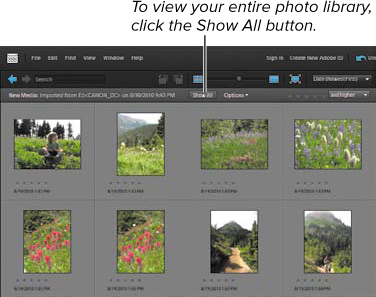
 Photos downloaded from the camera or memory card appear in the Organizer.
Photos downloaded from the camera or memory card appear in the Organizer.
To import images from a digital camera (Advanced dialog):
- Follow steps 1 through 8 in the previous sequence, but click the Advanced Dialog button in step 2 to switch to the Advanced dialog
 .
.
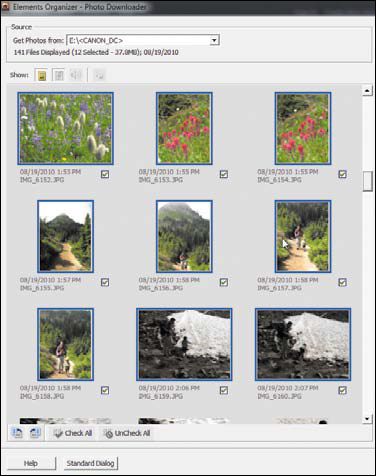
 Preview all photos on your camera before importing them in the Advanced dialog (left side of window shown here).
Preview all photos on your camera before importing them in the Advanced dialog (left side of window shown here). - Click to deselect the checkbox under any photos you do not want to download.
By default, the Photo Downloader assumes you want to download every image.
- In the Advanced Options area, choose to enable or disable the following
 :
:
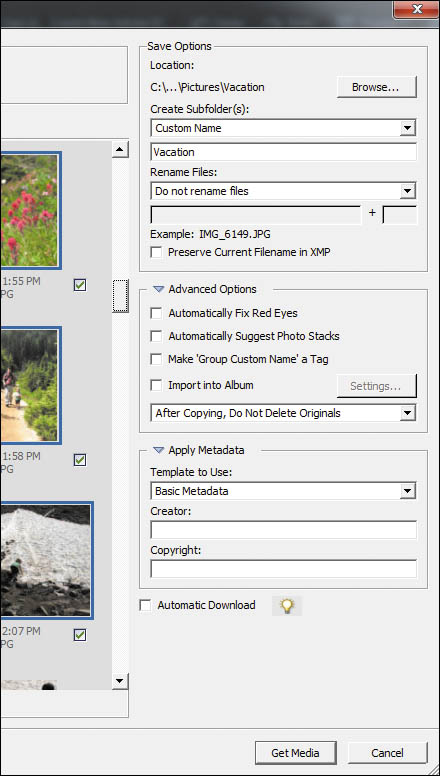
 Further customize the importing process in the Advanced dialog (right side of window here).
Further customize the importing process in the Advanced dialog (right side of window here).• Automatically Fix Red Eyes attempts to correct red eye problems in your photos as they’re downloaded.
• Automatically Suggest Photo Stacks groups similar photos together for easy organization and review later (see “Using Stacks to Organize Similar Photos,” later in this chapter).
• Make ‘Group Custom Name’ a Tag takes the name you specified in Step 5 two pages back and creates a keyword tag (see “Creating Keyword Tags,” later in this chapter).
• Import into Album assigns the photos to a photo album you’ve previously set up (see “Using Albums to Arrange and Group Photos,” later in this chapter).
- Type your name (or the name of whoever took the photos) and a copyright notice in the Apply Metadata fields. This text is embedded with the image files.
- If you want to rotate an image, select it and click the Rotate Left or Rotate Right buttons at the lower-left corner
 . You can also press Control and the left or right arrow keys.
. You can also press Control and the left or right arrow keys.
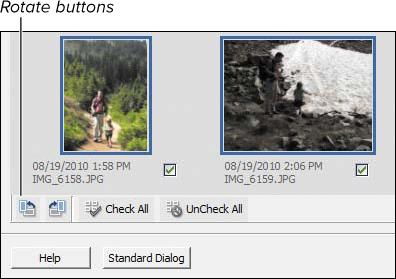
 Rotate images during import so you won’t have to do it later.
Rotate images during import so you won’t have to do it later.
Tip
For a fast way to select just a few photos for import, first click the UnCheck All button, and then click on the photos you want—don’t worry about clicking their individual checkboxes. With the images selected, click just one checkbox to enable the boxes of your selections.
Tip
Photoshop Elements can import photos stored in Camera RAW formats, which are the unprocessed versions of the captured images. RAW enables more adjustment possibilities than JPEG (which is processed and compressed in the camera). Elements brings RAW files into the Organizer without editing the image information. When you edit the photo, Elements first brings up the Camera Raw dialog to set initial edits before opening the image in the Editor. For more information, see “Adjusting Camera Raw Photos” in Chapter 7.
Tip
The contents of the Creator and Copyright metadata fields are applied to all photos imported in that batch. If you want different authors for the pictures, for example, either import them in several batches or edit the metadata after they’ve been added to the catalog.
To import images from files or folders:
- In the Organizer, go to the File menu, highlight Get Photos, and choose From Files and Folders.
If you insert media that contains pictures, such as a CD, Windows may ask what action you’d like to take (if you haven’t specified it already). Click the icon labeled Organize and Edit using Adobe Photoshop Elements 9.0, which opens the Get Photos from Files and Folders dialog.
- Select the files you want to import
 ; Shift-click to select a consecutive range of files, or Ctrl-click to select noncontiguous files.
; Shift-click to select a consecutive range of files, or Ctrl-click to select noncontiguous files.
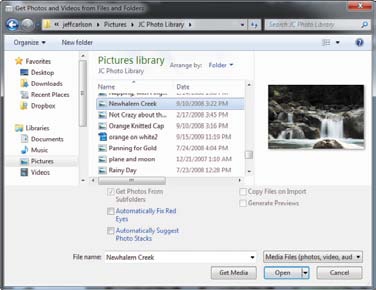
 Import images from other areas of your hard disk or from removable media such as CDs.
Import images from other areas of your hard disk or from removable media such as CDs. - If the images are stored on removable media and you want to import only low-resolution versions, disable the Copy Files on Import option and enable the Generate Previews option (see the sidebar for more information).
- As in the Advanced dialog mentioned on the previous pages, select from the processing options below the preview.
- Click the Get Media button to import the photos. If the photos already include keyword tags, you have the option to import them.
Tip
Now that we’ve gotten those steps out of the way and you understand what’s going on, here’s a much quicker method: Simply drag image files from a folder on your hard disk to the Organizer’s window. Elements imports them without fuss.
Tip
If you know some photos exist on your hard disk but can’t find them, let Elements hunt for them instead. Under the Get Photos submenu of the File menu, choose By Searching, enter criteria about the files, and click the Search button.
To import images using Watch Folders:
- You can specify one or more folders that Elements watches in the background for new files. In the Organizer, choose Watch Folders from the File menu.
- Click the Add button and navigate to the folder you wish to watch
 . Repeat for as many folders as you’d like.
. Repeat for as many folders as you’d like.

 Elements can keep an eye on one or more folders and import photos when they’re added.
Elements can keep an eye on one or more folders and import photos when they’re added. - Select an action under When New Files are Found in Watched Folders; Elements can notify you when files are found, or add them to the Organizer automatically.
- Click OK when you’re done.
- When you add photos to your watched folder, Elements asks if you want to import them (if you opted to be notified in step 3). Click Yes to add the photos, which are moved from the watched folder to the directory where Elements stores your catalog.
To scan an image into the Organizer:
- Connect the scanner to your computer using the instructions provided by the scanner manufacturer.
- In the Organizer, go to the Get Photos menu under the File menu and choose From Scanner.
- Select your scanner software from the Scanner pop-up menu
 .
.
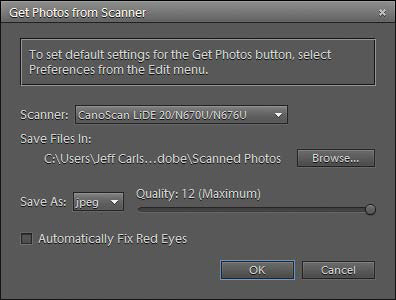
 Elements works with your scanner’s software to import images.
Elements works with your scanner’s software to import images. - Choose an image format and quality level, and optionally enable the Automatically Fix Red Eyes checkbox.
- Click the OK button. Elements hands off the actual scanning duties to the scanner’s software for you to complete the scan.
- When you complete the scan and exit the scanner’s software, Elements imports the image to your catalog.
Tip
If you’re planning to use only part of an image, you’ll save a lot of time by using your scanning software to crop your image before importing it into Photoshop Elements ![]() .
.
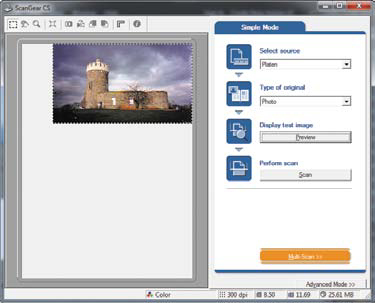
![]() Crop your images before importing them. In this figure, Canon’s ScanGear software handles the actual scan, but the photo ends up in Elements.
Crop your images before importing them. In this figure, Canon’s ScanGear software handles the actual scan, but the photo ends up in Elements.
Tip
On the off chance that you want to scan an image in black and white (not grayscale), well, don’t. Elements doesn’t recognize bitmap images.
To capture frames from video footage:
- In the Editor, go to the File menu and choose Import > Frame From Video. (This feature appears only in the Editor, not the Organizer.)
The Frame From Video dialog appears.
- Click the Browse button to locate the file you want, and then click Open to see the video footage.
The video clip appears in the dialog
 .
.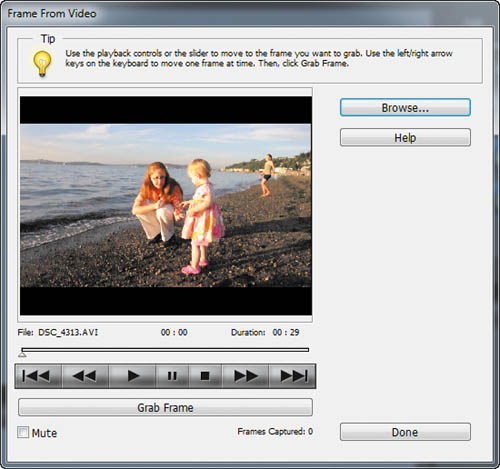
 The Frame From Video dialog enables you to snag shots from video footage you captured.
The Frame From Video dialog enables you to snag shots from video footage you captured. - To view your footage, click the Play button. When you see the frame you want, click the Grab Frame button.
To grab the frame you want, you can also use the Pause button to stop the video at the desired frame. Another useful option is to simply move the slider to the correct frame in the video.
- Grab as many video frames as you want, one by one, and then click Done.
As you click the Grab Frame button, the images appear as new files in the Editor
 .
.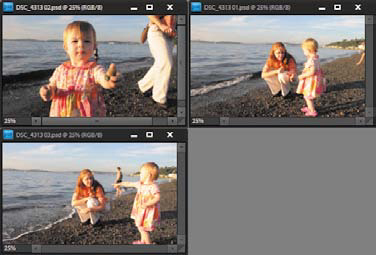
 I grabbed three frames from the video clip, which appear in the Editor as three separate image files.
I grabbed three frames from the video clip, which appear in the Editor as three separate image files. - Once you’ve captured the frames, you can save and edit them just like other images.
Tip
You’ll likely encounter a greater variety of exposure problems with video frames than with the still shots you take with a digital camera. You can easily fix contrast and tonal problems with a few of Photoshop Elements’ correction tools, which you’ll explore more in Chapter 6 and in Chapter 7.
Understanding the Organizer Work Area
The Organizer is divided into two main components: the Photo Browser and the Organize Bin. The Photo Browser, along with its timeline, is used to find and view thumbnail representations of your photos. The Organize Bin contains the Albums and Keyword Tags panels you’ll use to group and organize your image files ![]() .
.
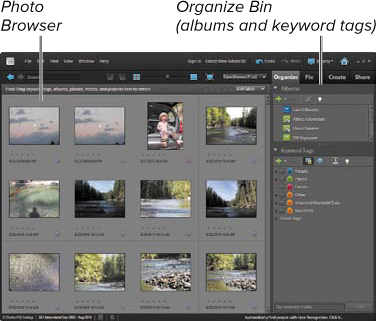
![]() The Organizer workspace makes it easy to browse your entire photo collection.
The Organizer workspace makes it easy to browse your entire photo collection.
The Photo Browser
At the core of the Organizer is the Photo Browser. Every digital photo or video downloaded into Photoshop Elements is automatically added there. Resizable thumbnails in the Photo Browser window make it easy to scan through even a large number of images.
The Organize Bin
The Organize Bin on the right side of the window holds the Albums and Keyword Tags panels. You use these to identify, sort, and organize your photos ![]() .
.
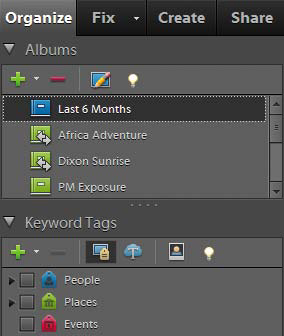
![]() The Organize Bin contains panels for albums and keyword tags.
The Organize Bin contains panels for albums and keyword tags.
The timeline
An optional, but helpful, way to quickly navigate your photos by date is the timeline, located just above the Photo Browser. Choose Timeline from the Window menu, or press Ctrl+L. For example, when a Date viewing option is selected in the Browser window, the timeline uses date and time information embedded in each image to construct bars (month markers) to represent sets of photos taken within specific months and years. When a month marker is selected in the timeline, that month’s photos are displayed at the top of the Photo Browser ![]() .
.
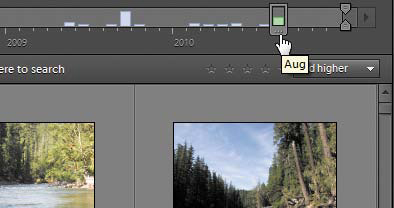
![]() Click a month marker in the Organizer timeline to view that month’s photos on the Photo Browser.
Click a month marker in the Organizer timeline to view that month’s photos on the Photo Browser.
Working in the Photo Browser
The centerpiece of the Organizer is the Photo Browser, a flexible workspace that provides a number of options for customizing the way you manage and view your image files. Throughout this chapter I’ll cover a variety of ways to work in the Photo Browser to label, identify, and organize your photos. But first it’s important to know how best to select, sort, and display the image thumbnails.
To select photo thumbnails:
Do one of the following:
• Click to select a thumbnail in the Photo Browser. The frame around it becomes light gray, indicating that the thumbnail is selected ![]() .
.
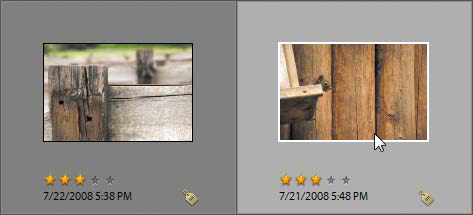
![]() A selected thumbnail appears with a light gray frame around it.
A selected thumbnail appears with a light gray frame around it.
• Ctrl-click to select several non-adjacent thumbnails at once ![]() .
.
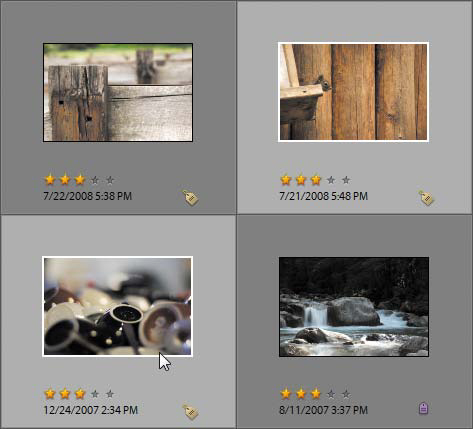
![]() Ctrl-click to select thumbnails that are not consecutive.
Ctrl-click to select thumbnails that are not consecutive.
• Shift-click to select a group of thumbnails in sequence ![]() .
.
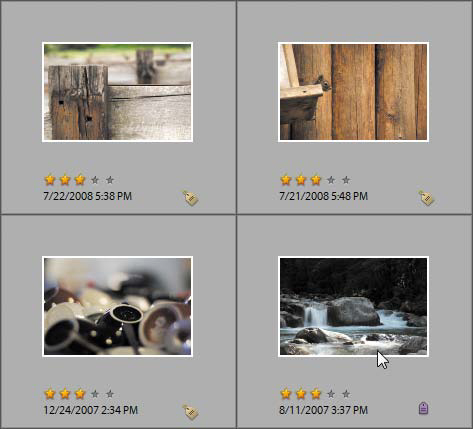
![]() Shift-click to select thumbnails that are consecutive.
Shift-click to select thumbnails that are consecutive.
• From the Edit menu, choose Select All, or press Ctrl+A to select every thumbnail in the Photo Browser.
To deselect photo thumbnails:
Do one of the following:
• Ctrl-click to deselect a single thumbnail.
• From the Edit menu, choose Deselect, or press Ctrl+Shift+A to deselect every thumbnail in the Photo Browser.
Tip
You can tweak the appearance of the Photo Browser. From the View menu, you can choose to display details such as filenames, ratings, timestamps, and people recognition.
To sort photo thumbnails:
• From the Arrangement drop-down menu above the Photo Browser, choose a sorting option ![]() :
:

![]() Select an option to sort thumbnails in the Photo Browser.
Select an option to sort thumbnails in the Photo Browser.
• Date (Newest First) displays the most recent photos at the top, judged by the images’ creation dates.
• Date (Oldest First) displays photos in order, with the oldest at the top.
• Click the Display button to choose how photos are grouped:
• Thumbnail View (Ctrl+Alt+1) is the default grid of thumbnails.
• Import Batch (Ctrl+Alt+2) groups photos into the batches they were imported in. Included is information on when the batch was imported and from what source ![]() .
.

![]() When you select the Import Batch option, thumbnails in the Photo Browser are displayed in grouped batch sets.
When you select the Import Batch option, thumbnails in the Photo Browser are displayed in grouped batch sets.
• Folder Location (Ctrl+Alt+3) displays photos grouped into the folders in which they’re stored, and provides detailed file-path information to make it easy to locate the folder and original files on your hard drive.
To resize photo thumbnails:
• Above the Photo Browser, drag the thumbnail slider to the right to increase the size of the thumbnails, or to the left to make them smaller ![]() .
.
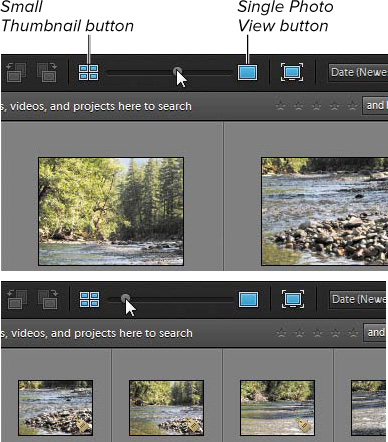
![]() When you drag the thumbnail slider to the right, the thumbnails grow larger (top). When you drag the slider to the left, they become smaller (bottom).
When you drag the thumbnail slider to the right, the thumbnails grow larger (top). When you drag the slider to the left, they become smaller (bottom).
• Click the Small Thumbnail button to the left of the slider to display the thumbnails at their smallest possible size.
• Click the Single Photo View button to the right of the slider to display just one large photo thumbnail at a time.
Tip
Double-click on any thumbnail to change to Single Photo View. Double-click the image to return to your most recent multiple thumbnail view settings.
Displaying and Changing Information for Your Photos
Images you import from a digital camera or scanner carry embedded file information— everything from the date and time a photo was shot or scanned to whether or not the camera’s flash fired. The Organizer uses that date and time information to determine the display order of the photo thumbnails in the Photo Browser.
If your camera’s clock wasn’t set properly before shooting (a problem especially if the batteries die), the Adjust Date and Time dialog lets you substitute a new date and time for any image file. You can also easily adjust for time zone differences by shifting the time a set number of hours.
To adjust the date and time:
- From the View menu, check that the Details option is enabled
 to display date and filename information below the image thumbnails.
to display date and filename information below the image thumbnails.

 The Details option displays title and date information in the Photo Browser.
The Details option displays title and date information in the Photo Browser. - In the Photo Browser, click to select the thumbnails whose date and time you would like to change.
- From the Edit menu, choose Adjust Date and Time (or Adjust Date and Time of Selected Items if more than one thumbnail is selected), or press Ctrl+J.
- In the Adjust Date and Time of Selected Items dialog, choose one of the options and click OK
 :
:

 The Adjust Date and Time dialog offers different options for changing an image’s date and time information.
The Adjust Date and Time dialog offers different options for changing an image’s date and time information.• Change to a specified date and time opens the Set Date and Time dialog where you can set a specific year, month, day, and time
 .
.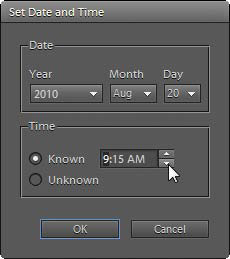
 The Set Date and Time dialog.
The Set Date and Time dialog.• Change to match file’s date and time reverts the date and time information to what is embedded in the original image file.
Remember, date and time changes you enter here are only for sorting and organizing your images within the Photo Organizer.
• Shift by set number of hours (time zone adjust) adjusts the time of selected images forward or backward by the number of hours that you specify
 .
.
 Use the Time Zone Adjust dialog to set the time of your images backward or forward in one-hour intervals.
Use the Time Zone Adjust dialog to set the time of your images backward or forward in one-hour intervals.
Tip
A preference enables you to open the Adjust Date and Time dialog by simply clicking on the date in the Photo Browser. From the Edit menu, choose Preferences > General, and then select the Adjust Date and Time by Clicking on Thumbnail Dates option.
To rate a photo:
- In the Photo Browser, position your mouse pointer over the gray star icons; they change to yellow depending on the pointer’s location
 .
.
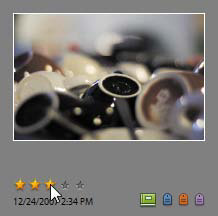
 Apply a rating to quickly identify your higher-quality photos.
Apply a rating to quickly identify your higher-quality photos. - Click to select the rating you wish to apply: One star typically denotes a low-quality photo, while five stars is excellent. (You can choose your own values, of course; this feature provides an easy way to separate good from bad photos, as you’ll see later in “Using Smart Albums.”)
To add a caption to a photo:
- Click to select an image thumbnail.
- From the Edit menu, choose Add Caption, or press Ctrl+Shift+T.
- In the Add Caption dialog, type a caption for your image, and then click OK
 . Although captions don’t display with images in the Photo Browser, they do appear along with your photos when you create projects such as Web Photo Galleries and Photo Album Pages.
. Although captions don’t display with images in the Photo Browser, they do appear along with your photos when you create projects such as Web Photo Galleries and Photo Album Pages.
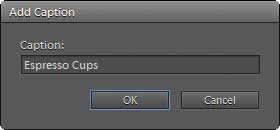
 The Add Caption dialog.
The Add Caption dialog.
Tip
You can also add and edit captions in Single Photo View. In Single Photo View, click the Click here to add caption text. The text changes to a text field where you can type a new caption. If you’ve previously entered a caption, click on the text to edit or delete it.
Tip
You can add the same caption to multiple images at the same time. Select a group of images in the Photo Browser, and then from the Edit menu choose Add Caption to Selected Items. The caption you enter in the Add Caption to Selected Items dialog is applied to the selected images.
To rename a photo:
- In the Photo Browser, click to select an image thumbnail.
- From the Window menu, choose Properties, or press Alt+Enter to open the Properties panel.
- Enter a new name for your image file in the Name field.
To add a note to a photo:
- Select an image thumbnail.
- From the Window menu, choose Properties, or press Alt+Enter to open the Properties panel.
- In the Notes field, enter the text you want to include with your photo
 .
.
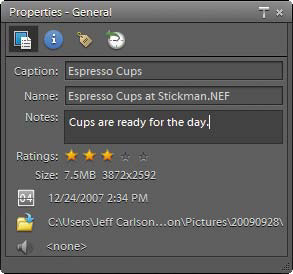
 Notes entered for images are accessible only in the Properties panel.
Notes entered for images are accessible only in the Properties panel.
Creating Keyword Tags
The humble little tag serves as the foundation for the Organizer’s sorting and filing system. You can create a tag from scratch or create one based on a set of photos grouped within a folder. Use names that are descriptive, but not so specific that they apply only to a limited number of photos.
To create a new keyword tag:
- Click the New button (the plus sign) at the top of the Keyword Tags panel.
- From the drop-down menu, choose New Keyword Tag or press Ctrl+N
 . The Create Keyword Tag dialog appears.
. The Create Keyword Tag dialog appears.
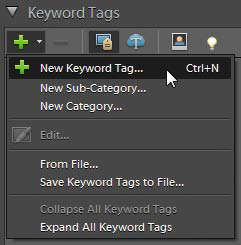
 Click the New button at the top of the Keyword Tags panel to create a new tag.
Click the New button at the top of the Keyword Tags panel to create a new tag. - From the Category menu, choose the category or sub-category in which you want to place your new tag
 .
.
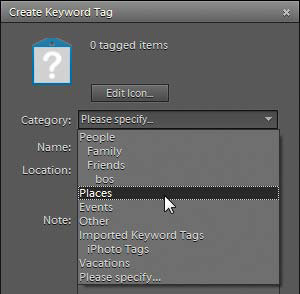
 All tags reside in categories. Define a category for your new tag in the Create Keyword Tag dialog.
All tags reside in categories. Define a category for your new tag in the Create Keyword Tag dialog. - In the Name text field, enter a name for your tag.
- In the Note text field, enter information relevant to the photos that will have the tag applied.
- Click OK to close the dialog.
Your new tag appears in the Keyword Tags panel within the category you chose
 .
.
 Tags appear nested below their categories in the panel.
Tags appear nested below their categories in the panel.
Tip
The first photo to which you attach a new tag automatically becomes the icon for that tag. This is an easy and convenient way to assign tag icons, so I’ll ignore the Edit Icon button for now.
Tip
You can associate a location with a tag (whether or not it’s categorized as Places) by clicking the Place on Map button in the Create Keyword Tag dialog. See “Using the Map,” later in this chapter.
To import tags from other images:
- Using the steps outlined earlier, import photos from your hard disk that may already contain keywords (for example, if someone sent you the images or you used another program to assign tags).
- In the Import Attached Keyword Tags dialog, choose which tags you want to add to your list. Click OK. The tags can be applied to any photos in your library.
Tip
Click the Advanced button to access more options such as renaming the tags before they’re imported ![]() .
.
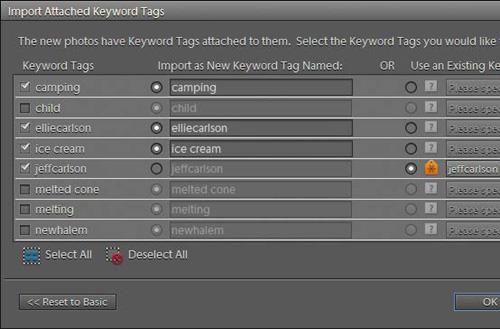
![]() When you import photos that already contain keyword tags, you can opt to add them to the list in the Keyword Tags panel.
When you import photos that already contain keyword tags, you can opt to add them to the list in the Keyword Tags panel.
To create a tag using the Keyword Tags field:
- Select one or more images in your library.
- Type a keyword in the Tag selected media field
 . (Note that the field moved from the top to the bottom of the panel between versions 8 and 9 of Photoshop Elements.)
. (Note that the field moved from the top to the bottom of the panel between versions 8 and 9 of Photoshop Elements.)
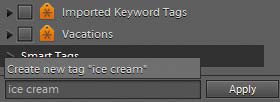
 Type a word into the Keyword Tags field to create a new tag for it.
Type a word into the Keyword Tags field to create a new tag for it.Better yet, type several keywords, separated by commas, to create and apply them together.
- Press Enter or click Apply. The new tag is created and applied to the image.
Tip
I’m happy to detail the different methods of creating and applying keyword tags in this chapter, but for me, the capability to do it from the Tag selected media field trumps the other methods. It’s quick, and promises to make keyword tagging much less of a chore than in the past.
To change a tag’s properties:
- In the Keyword Tags panel, select the tag you want to edit.
- Click the New button (the plus sign) and choose Edit
 .
.
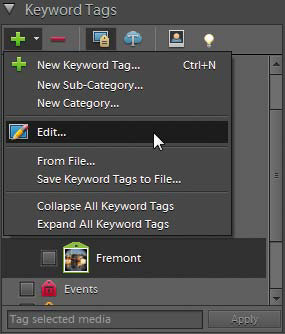
 Edit a tag’s properties.
Edit a tag’s properties.Or
- In the Keyword Tags panel, right-click the tag whose properties you would like to change.
- From the tag contextual menu, choose Edit (name of tag) keyword tag.
- In the Edit Keyword Tag dialog, make the desired changes and click OK.
To delete a tag:
In the Keyword Tags panel, select the tag you want to delete and click the Delete button (the red minus sign) ![]() .
.
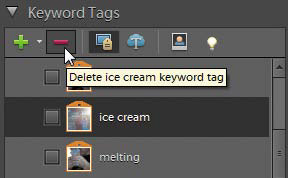
![]() Delete a keyword tag you don’t want to use.
Delete a keyword tag you don’t want to use.
Or
- In the Keyword Tags panel, right-click on the tag you would like to delete.
- From the tag contextual menu, choose Delete (name of tag) keyword tag.
- In the Confirm Keyword Tag Deletion warning box, click OK
 .
.
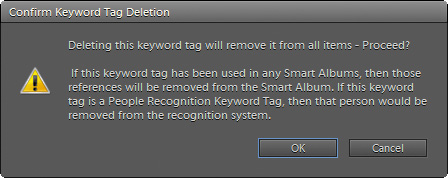
 The Confirm Tag Deletion warning box reminds you that when a tag is deleted from the Keyword Tags panel, the tags are also removed from the thumbnails in the Photo Browser.
The Confirm Tag Deletion warning box reminds you that when a tag is deleted from the Keyword Tags panel, the tags are also removed from the thumbnails in the Photo Browser.The tag is removed from the Keyword Tags panel and from any photos tagged in the Photo Browser.
Using Keyword Tags to Sort and Identify Photos
Tags operate independent of where photos are located on your computer, which means you can attach a tag to photos in different folders—even on different hard drives—and then use that tag to quickly find and view those photos all at once.
To attach a tag to a single photo:
• Drag a tag from the Keyword Tags panel onto any photo in the Photo Browser ![]() .
.
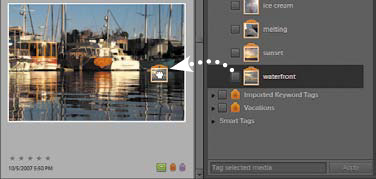
![]() To attach a tag to a photo, drag it from the Keyword Tags panel to a thumbnail image in the Photo Browser.
To attach a tag to a photo, drag it from the Keyword Tags panel to a thumbnail image in the Photo Browser.
• Type a term into the Keyword Tags field; if the tag already exists, click it from the pop-up list that appears ![]() .
.

![]() Existing tags appear as you type into the Keyword Tags field.
Existing tags appear as you type into the Keyword Tags field.
A category icon appears below the photo in the Browser window to indicate that it has been tagged; in the Keyword Tags panel, the tag assumes that photo for its tag icon ![]() .
.
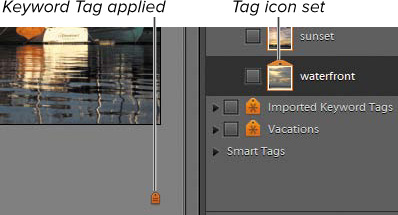
![]() When you use a tag for the first time, the photo you attach it to is used for the tag’s icon.
When you use a tag for the first time, the photo you attach it to is used for the tag’s icon.
To attach a tag to multiple photos:
- In the Photo Browser, Ctrl-click to select any number of photos.
- From the Keyword Tags panel, drag a tag onto any one of the selected photos
 .
.

 You can select multiple photos, and then tag them all by dragging a tag icon over just one.
You can select multiple photos, and then tag them all by dragging a tag icon over just one.A category icon appears below all of the selected photos in the Browser window to indicate that they have been tagged.
To attach a tag to an import batch or folder:
- From the Display drop-down menu, choose either Import Batch or Folder Location.
- Identify the import batch or folder group you want to tag, and then click on either the import batch or folder icon at the top of the window for that group
 .
.
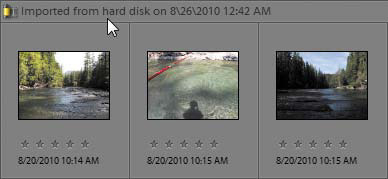
 When you click on an import batch or folder icon, all of the photos in that batch or folder are selected at once.
When you click on an import batch or folder icon, all of the photos in that batch or folder are selected at once.All of the photos in the group are automatically selected.
- From the Keyword Tags panel, drag a tag onto any one of the selected photos.
A category icon appears below all the selected photos.
To view a set of tagged photos:
In the Keyword Tags panel, do one of the following:
• Double-click a tag.
• Click the blank box to the left of a tag.
A small binoculars icon appears in the box, and the Photo Browser will change to display just the photo or photos that carry the attached tag ![]() .
.

![]() When the binoculars icon is visible next to a tag in the Keyword Tags panel, only that tag’s photos appear in the Photo Browser.
When the binoculars icon is visible next to a tag in the Keyword Tags panel, only that tag’s photos appear in the Photo Browser.
To view all photos again, click the Show All button, or click the binoculars icon in the Keyword Tags panel.
To remove a tag from a photo:
Select a photo thumbnail in the Photo Browser, and then do one of the following:
• Right-click a photo thumbnail; then, from the contextual menu, choose Remove Keyword Tag > (name of tag).
• Right-click on the category icon below the photo thumbnail and select Remove (name of tag) Keyword Tag from the contextual menu ![]() .
.

![]() Remove a tag from a photo with a single click on the category icon below the thumbnail in the Photo Browser.
Remove a tag from a photo with a single click on the category icon below the thumbnail in the Photo Browser.
To change a tag’s icon:
- In the Keyword Tags panel, right-click on the tag you would like to change.
- From the tag drop-down menu, choose Edit (name of tag) keyword tag.
- In the Edit Keyword Tag dialog, click the Edit Icon button.
To assign a new icon image in the Edit Tag Icon dialog, you can select from any of the photos that the tag has been applied to, or you can import a completely new photo.
- To select a different tagged photo, click the Find button
 .
.
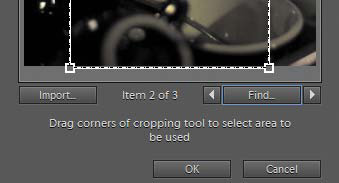
 Click the Find button in the Edit Tag Icon dialog to browse for a new photo to use as the source for your tag icon.
Click the Find button in the Edit Tag Icon dialog to browse for a new photo to use as the source for your tag icon. - In the Select Icon for (name of tag) Keyword Tag dialog, click to select a photo thumbnail and click OK
 .
.
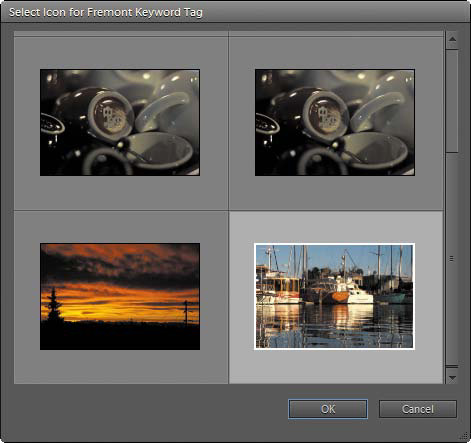
 The Select Icon dialog.
The Select Icon dialog.The new image appears in the preview window of the Edit Tag Icon dialog.
- To crop the area of the photo that will appear on the tag icon, click and drag any of the four cropping handles in the image preview
 .
.
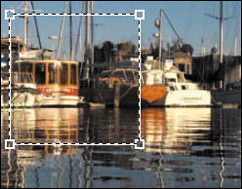
 Resize the selection rectangle in the Edit Tag Icon dialog to choose the visible area of the icon.
Resize the selection rectangle in the Edit Tag Icon dialog to choose the visible area of the icon. - To select a different cropped area of the photo to appear on the tag icon, click inside the crop box and drag it in the preview window
 .
.
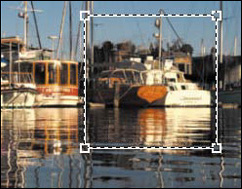
 Drag the selection rectangle to choose a different area of a photo to use for the tag icon.
Drag the selection rectangle to choose a different area of a photo to use for the tag icon. - When you’re satisfied with the look of your icon, click OK to close the Edit Tag Icon dialog, and then click OK again to close the Edit Keyword Tag dialog. The new icon appears on the tag in the Keyword Tags panel.
Tip
If you’d like to use an image for your icon different than any of the photos you’ve tagged, click the Import button in the Edit Tag Icon dialog to browse your computer and select an image.
Using the Keyword Tag Cloud
In addition to the hierarchical display of tags, you can view keywords in a “cloud”: All keyword tags are listed; terms applied more frequently appear in larger type. Click the Keyword Tag Cloud button in the Keyword Tags panel ![]() .
.
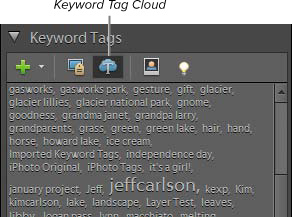
![]() Many photos include the keyword “jeffcarlson”, as indicated by the tags’ larger size.
Many photos include the keyword “jeffcarlson”, as indicated by the tags’ larger size.
To view photos using the Tag Cloud:
Click a keyword in the cloud to view all photos to which the tag is applied.
To apply a tag from the Tag Cloud to a photo:
- Ctrl-click one or more tags.
- Drag the tag(s) to one or more selected photos in the library.
To edit or delete a tag using the Tag Cloud:
- Double-click a tag to make it editable
 .
.
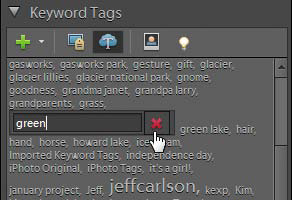
 You can edit or delete keyword tags directly in the Tag Cloud.
You can edit or delete keyword tags directly in the Tag Cloud. - Change the tag’s name in its text field and press Enter. Or, click the X button to remove it. If you decide not to do anything, click elsewhere in the Tag Cloud to deselect the tag. Deleting a tag removes it from all photos that possessed the tag.
Auto-Analyzing Photos
The Organizer can help you tag images using its Auto-Analyzer feature. It scans your library and applies Smart Tags for characteristics such as High Contrast, Blurred, Pan Motion, and more. You can then locate images using those criteria by choosing Smart Tags in the Keyword Tags panel.
To analyze selected photos:
- Select one or more photos in the library.
- Choose Edit > Run Auto-Analyzer, or right-click on a photo and choose Run Auto-Analyzer from the shortcut menu.
- After the Organizer analyzes the files, click OK.
The photos gain a Smart Tag icon; hold your pointer over the icon or right-click to reveal which tags were applied
 .
.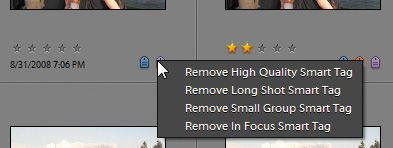
 The Organizer can apply tags based on its analysis of an image.
The Organizer can apply tags based on its analysis of an image.
To analyze photos automatically:
- Go to Edit > Preferences > Media Analysis to view controls for the feature.
- Enable the Analyze Media for Smart Tags Automatically option
 .
.
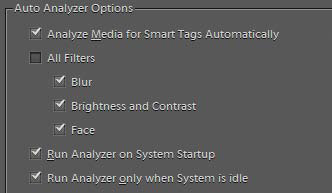
 Choose which attributes are considered in the image analysis.
Choose which attributes are considered in the image analysis.You can also choose which filters to apply; for example, if you don’t store any audio or video files in the Organizer, you may want to disable the Audio filter. Click OK.
Tip
Hover over the Auto-Analyzer status icon to check or pause the analysis ![]() .
.

![]() Auto-Analyze can take a while, but you can check its status.
Auto-Analyze can take a while, but you can check its status.
Tip
In the preferences, enable the “Run Analyzer only when System is idle” option to prevent the Organizer from monopolizing your computer’s processors.
Tip
If you’ve installed only Photoshop Elements, just three filters are available in the preferences: Blur, Brightness & Contrast, and Face. With Premiere Elements also installed, additional filters appear in ![]() .
.
Using Face Recognition
The Find People for Tagging feature offers an easy way to sort, identify, and tag photos based on the people in them.
To identify a person:
- Double-click a photo containing a person to view it full-size.
- When the Organizer displays a “Who is this?” field, click it and do one of the following:
• Type a name
 . If it’s a new person, a new keyword tag is created under the People category and applied to the photo.
. If it’s a new person, a new keyword tag is created under the People category and applied to the photo.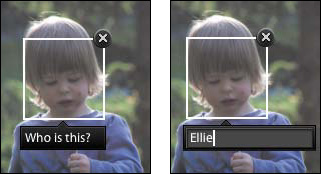
 When the Organizer asks, click and enter a name in the “Who is this?” field.
When the Organizer asks, click and enter a name in the “Who is this?” field.• Click the name of an existing tag that appears below the field.
• The Organizer will start to make suggestions as the database of faces grows
 . Click the green checkmark button if the suggestion is correct; click the red button to enter a different name.
. Click the green checkmark button if the suggestion is correct; click the red button to enter a different name.
 As the database of recognized photos builds, the Organizer attempts matches.
As the database of recognized photos builds, the Organizer attempts matches. - If a person is in the picture but wasn’t identified, click the Add Missing Person button (in the lower right corner of the window), draw a box around their face, and then enter the person’s name.
Tip
If you want to identify faces in a large number of photos, choose Find > Find People for Tagging, or click the Start People Recognition button in the Keyword Tags panel. The Organizer displays photos zoomed in on faces for faster labeling ![]() .
.
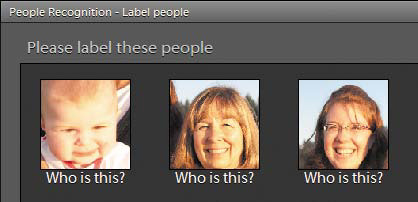
![]() The Organizer finds the face, but needs your help identifying it.
The Organizer finds the face, but needs your help identifying it.
Using Categories to Organize Tagged Photos
All tags must reside in either a category or sub-category. The Organizer starts you off with four ready-made categories, but you can create as many new categories and subcategories as you want. Tags can be easily moved from one category to another and also converted to a sub-category that contains its own set of tags.
To create a new category:
- Click the New button at the top of the Keyword Tags panel.
- From the New drop-down menu, choose New Category to open the Create Category dialog
 .
.
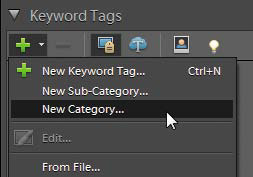
 Use the New menu in the Keyword Tags panel to open the Create Category dialog.
Use the New menu in the Keyword Tags panel to open the Create Category dialog. - In the Create Category dialog, enter a name in the Category Name text field.
- In the Category Icon area of the dialog, use the scroll bar or arrows to search for an icon you would like to use to identify your new category
 .
.
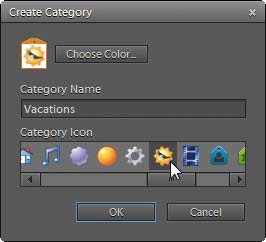
 The Create Category dialog includes a variety of icons you can use to represent your new category.
The Create Category dialog includes a variety of icons you can use to represent your new category. - Click to select a category icon. The icon appears in the category preview at the top of the dialog.
- At the top of the dialog, click the Choose Color button to open the Color Picker.
- Select the color you would like to appear on all the sub-category and tag icons within your new main category and click OK
 .
.

 The color you choose in the Color Picker appears on the icons for tags in your new category.
The color you choose in the Color Picker appears on the icons for tags in your new category. - If you’re satisfied with your other category settings, click OK to close the Create Category dialog.
Your new category appears at the bottom of the Keyword Tags panel.
To create a new sub-category:
- Click the New button at the top of the Keyword Tags panel.
- From the New drop-down menu, choose New Sub-Category to open the Create Sub-Category dialog.
- In the Create Sub-Category dialog, enter a name in the Sub-Category Name text field.
- From the Parent Category or Sub-Category drop-down menu, choose a location in which to place your new sub-category
 .
.
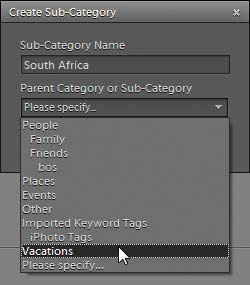
 Sub-categories can be nested within categories or other sub-categories.
Sub-categories can be nested within categories or other sub-categories. - Click OK to close the Create Sub-Category dialog.
- Your new sub-category appears in the Keyword Tags panel, within the category or sub-category you selected.
To convert a tag to a sub-category:
- In the Keyword Tags panel, right-click on the tag you want to convert.
- From the tag contextual menu, choose Change (name of tag) keyword tag to a sub-category
 . The tag icon changes to a sub-category icon.
. The tag icon changes to a sub-category icon.
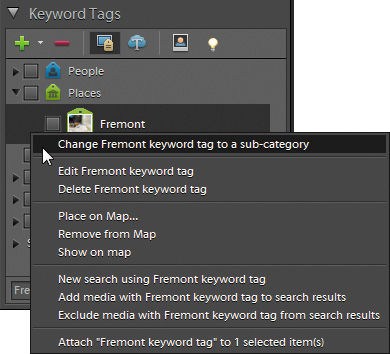
 Convert a tag to a sub-category from the tag contextual menu in the Keyword Tags panel.
Convert a tag to a sub-category from the tag contextual menu in the Keyword Tags panel.
Tip
If you decide you’d like to convert a sub-category (that was formerly a tag) back to a tag, go to the Sub-Category contextual menu and choose the Change sub-category to a tag option. All the tag’s properties, including its icon, are retained.
To assign a tag to a new category or sub-category:
- In the Keyword Tags panel, right-click the tag you want to place.
- From the tag contextual menu, choose Edit (name of tag) keyword tag.
- From the Category menu in the Edit Keyword Tag dialog, choose the category or sub-category in which you want to place the tag
 .
.
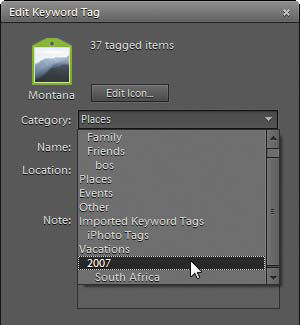
 You can easily move a tag from one category to another using the Edit Keyword Tag dialog.
You can easily move a tag from one category to another using the Edit Keyword Tag dialog. - Click OK to close the Edit Keyword Tag dialog. In the Keyword Tags panel, the tag appears within the category and sub-category you defined
 .
.
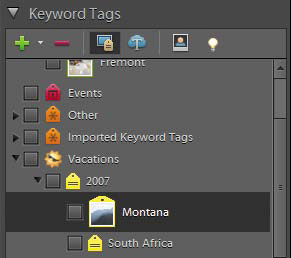
 Changes you make to a tag’s placement in the Edit Keyword Tag dialog appear instantly in the Keyword Tags panel.
Changes you make to a tag’s placement in the Edit Keyword Tag dialog appear instantly in the Keyword Tags panel.If you’ve already applied the tag to a photo or photos in the Photo Browser, the category icons below the photo thumbnails will automatically update to display the icon of the new category.
Tip
You can also move tags into new categories or sub-categories right in the Keyword Tags panel. With both the tag and the category or sub-category visible, simply click to select a tag and then drag it onto a category or sub-category icon. The tag will nest beneath the category or sub-category you choose. The disadvantage of this method (as compared to the one outlined in the procedure) is that you must be able to see the tag and category or sub-category in the Keyword Tags panel. Since the Keyword Tags panel can get filled with categories quickly, it may require that you do quite a bit of scrolling and searching, whereas the Category menu in the Edit Keyword Tag dialog gives you a list of every category and sub-category in one convenient place.
To view photos belonging to a category or sub-category:
In the Keyword Tags panel, do one of the following:
• Double-click a category or sub-category.
• Click the blank box to the left of a category or sub-category.
A small binoculars icon appears in the box, and the Photo Browser changes to display just the photos in that category or sub-category set.
To return to the main Photo Browser window, click the Show All button, or click the binoculars icon in the Keyword Tags panel.
To delete a category or sub-category:
In the Keyword Tags panel, click a category or sub-category, and then do one of the following:
• Right-click to display the category contextual menu, and then select Delete (category name) category.
• Click the Delete icon at the top of the Keyword Tags panel ![]() .
.
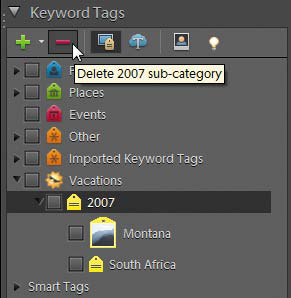
![]() Delete a category or tag from the Keyword Tags panel by clicking the Delete button.
Delete a category or tag from the Keyword Tags panel by clicking the Delete button.
Tip
Before you delete a category or sub-category, bear in mind that you will also delete all related sub-categories and tags and will remove those tags from all tagged photos. In some circumstances, a better alternative may be to change a category or sub-category’s properties to better match the content or theme of related tagged photos.
Using Albums to Arrange and Group Photos
Photos have gone digital, but we don’t have to discard our analog thinking. Just as you store Polaroids and prints in a photo album, you can collect your digital photos in Elements albums.
An album can be composed of photos from several different tags or categories. Plus, the photos within albums can be sorted and reordered, independent of their date or folder structure—particularly useful when you’re creating a project such as a PDF slide show or Web photo gallery.
To create a new album:
- Click the New button at the top of the Albums panel.
- From the New drop-down menu, choose New Album
 . The Organize panel fills with the Album Details dialog
. The Organize panel fills with the Album Details dialog  .
.
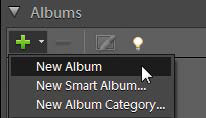
 Use the New menu in the Albums panel to open the Create Album dialog.
Use the New menu in the Albums panel to open the Create Album dialog.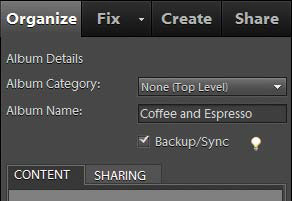
 The Album Details dialog uses the entire Organize pane while you’re creating an album.
The Album Details dialog uses the entire Organize pane while you’re creating an album. - Leave the Album Category menu set to None (Top Level). You’ll learn more about album categories later in this section.
- In the Album Name field, enter a name for your album.
- If you want to automatically back up the album, enable the Backup/Sync checkbox (see “Backing Up Photos Online,” later in this chapter).
- Drag the photos you want to add to the album to the Items field
 . Or, select one or more photos and click the Add (+) button.
. Or, select one or more photos and click the Add (+) button.
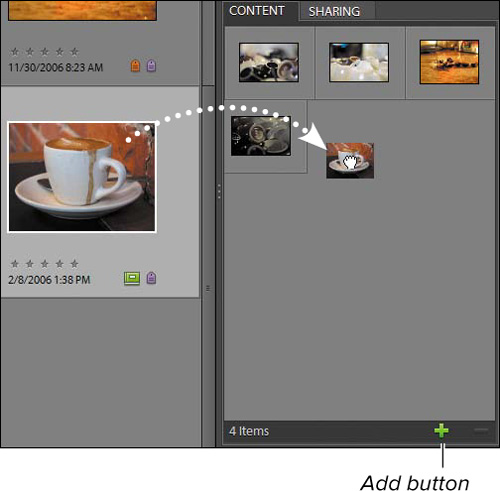
 Populate the album by dragging photos to it or by selecting them and clicking the Add button.
Populate the album by dragging photos to it or by selecting them and clicking the Add button. - Click Done to close the dialog. Your new album appears in the Albums panel. By default, albums are sorted in alphabetical order.
To create an album from a folder:
- Click the Display button and choose Folder Location to display your photos in folder groups.
- Identify the folder group you want and click the Create Instant Album button
 .
.

 Every folder group in the Photo Browser has its own Create Instant Album button.
Every folder group in the Photo Browser has its own Create Instant Album button.The album is created with the name of the folder
 .
.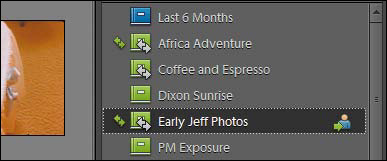
 The album is given the same name as its source folder.
The album is given the same name as its source folder.
To view a photo album:
Click an album name in the Albums panel. The Photo Browser displays only the photos in that album ![]() .
.
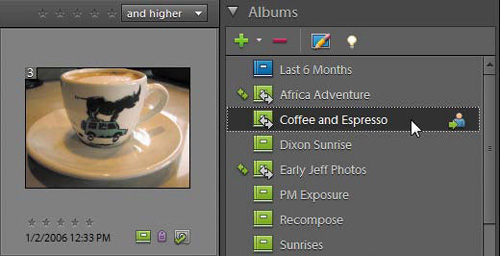
![]() Click an album name to view only its photos.
Click an album name to view only its photos.
To view your entire catalog, click the Show All button.
To add photos to an album:
Do one of the following:
• From the Photo Browser, drag a photo onto the appropriate album in the Albums panel.
• From the Albums panel, drag an album onto a photo thumbnail in the Photo Browser ![]() . An album icon appears below the photo in the Browser window to indicate it is part of an album.
. An album icon appears below the photo in the Browser window to indicate it is part of an album.
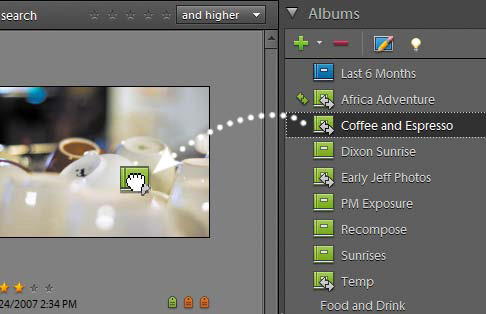
![]() One way to populate an album is to drag its icon from the Albums panel to one or more photos.
One way to populate an album is to drag its icon from the Albums panel to one or more photos.
Or
- In the Albums panel, select an album and click the Edit icon.
- Drag photos to the Items field; or, make selections in the Photo Browser and click the Add (+) button.
To rename an album:
- In the Albums panel, select an album and click the Edit icon.
- Change the Album Name field and click Done.
To arrange photos within an album:
- In the Albums panel, click an album name.
- In the Photo Browser, click to select a photo, and then drag it to a new location
 .
.
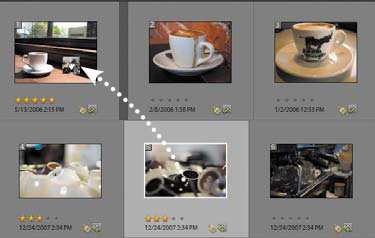
 To reorder photos within an album, drag a thumbnail to a new location in the Photo Browser. The numbers on the thumbnails indicate their order.
To reorder photos within an album, drag a thumbnail to a new location in the Photo Browser. The numbers on the thumbnails indicate their order.
Or
- In the Albums panel, select an album and click the Edit icon.
- Drag to rearrange the photos in the Items field.
To remove photos from an album:
With an album displayed in the Photo Browser, select a photo thumbnail and then do one of the following:
• Right-click on the album icon below the photo thumbnail and select Remove from (name of album) Album from the contextual menu ![]() .
.
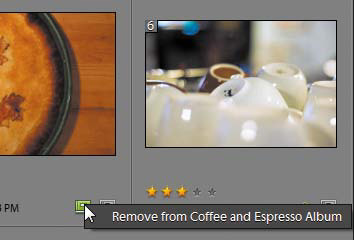
![]() Right-click a photo’s album icon to remove it from the album.
Right-click a photo’s album icon to remove it from the album.
• Right-click inside a photo thumbnail, and then from the contextual menu choose Remove from Album > (name of album).
Or
- In the Albums panel, select an album and click the Edit icon.
- Select one or more photos and click the Remove (–) button.
To create an album category:
- Click the New button at the top of the Albums panel.
- From the New drop-down menu, choose New Album Category to open the Create Album Category dialog.
- In the Album Category Name text field, enter a name
 .
.
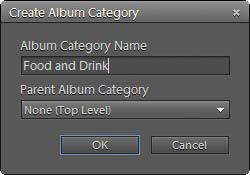
 The Create Album Category dialog.
The Create Album Category dialog.Tip
You can also right-click an album name and choose Sort the Album by Date (Oldest First) from the contextual menu.
- Leave the Parent Album Category option set to None (Top Level).
- Click OK to close the Create Album Category dialog.
Your new album category appears at the bottom of the list in the Albums panel.
To add an album to an album category:
In the Albums panel, drag an album icon onto the name of the album category ![]() .
.
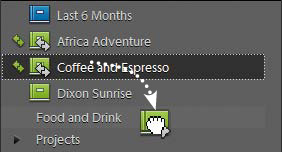
![]() Once you’ve created an album category, you can add albums to it from the Albums panel.
Once you’ve created an album category, you can add albums to it from the Albums panel.
Or
- In the Albums panel, right-click the album you want to include in the album category.
- From the album contextual menu, choose Edit (name of album) album.
- From the Group menu in the Edit Album dialog, choose the group in which you want to place the album.
- Click OK to close the Edit Album dialog. In the Albums panel, the album appears within the category you defined.
To delete an album:
In the Albums panel, select an album and click the Delete icon.
Or
- In the Albums panel, right-click the album you would like to delete.
- From the album contextual menu, choose Delete (name of album) album.
- In the Confirm Album Deletion warning box, click OK. The album is removed from the Albums panel, and the links to any images in the Photo Browser are broken.
Tip
It’s possible to group one album category within another when creating a category. If you’ve already created an album category, its name appears in the Parent Album Category menu of the Create Album Category dialog. You then have the option of nesting your new album category within the existing one.
Tip
Deleting a shared album also removes it from public view at Photoshop.com, although the photos remain online.
Using Smart Albums
One of my grandmother’s cupboards was filled with photo albums, organized roughly chronologically, along with a bunch of envelopes and stacks of free-floating pictures that weren’t in any order. The problem with lots of photos is that there’s only so much time you can spend sorting them.
But what if you had an assistant who could do the organizing for you? Not just once, but ongoing, changing the albums based on new photos or keyword tags or other criteria? Smart albums operate just like that (and they don’t mind the workload).
To create a smart album:
- Click the New button at the top of the Albums panel.
- From the New drop-down menu, choose New Smart Album to open the New Smart Album dialog.
- Type a descriptive title in the Name field.
- In the Search Criteria area, choose an attribute from the first drop-down menu
 .
.
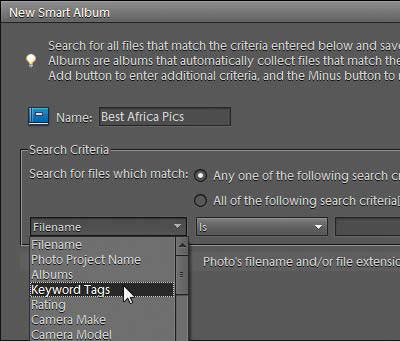
 Choose from several attributes to start building the smart album.
Choose from several attributes to start building the smart album.The other drop-down menu and field change depending on the criteria. For example, choosing Keyword Tags presents a list of tags.
- To add more criteria, click the plus button
 and specify the attributes.
and specify the attributes.

 Click here to add additional criteria.
Click here to add additional criteria. - By default, the album picks up photos containing any of the criteria you specify. To view only photos that match every attribute, choose the radio button labeled All of the following search criteria [AND]
 .
.

 This smart album will display only photos marked with the Vacations keyword tag and having a rating of 4 or 5 stars.
This smart album will display only photos marked with the Vacations keyword tag and having a rating of 4 or 5 stars. - Click OK. Only the images matching the criteria are displayed
 .
.
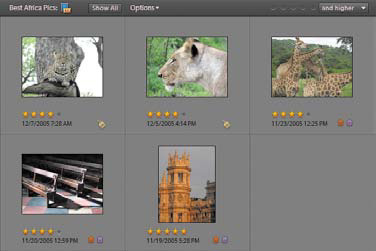
 After the smart album is created, the pictures that match its criteria are displayed.
After the smart album is created, the pictures that match its criteria are displayed.
To modify a smart album:
- Select a smart album in the Albums panel to view its contents.
- From the Options drop-down menu at the top of the Photo Browser, choose Modify Search Criteria
 .
.
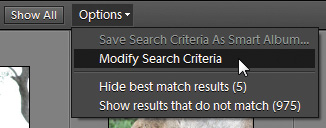
 Choose Modify Search Criteria when you’re viewing the contents of a smart album.
Choose Modify Search Criteria when you’re viewing the contents of a smart album. - In the Find by Details (Metadata) dialog that appears, edit the attributes you set up originally.
- To keep the new criteria, mark the checkbox labeled Save this Search Criteria as Smart Album
 .
.

 Make sure you mark the criteria as a smart album, or else Elements modifies the search for that instance only.
Make sure you mark the criteria as a smart album, or else Elements modifies the search for that instance only. - Enter a name for the album (see the tip below).
- Click Search to save the settings. The images in the Photo Browser reflect the new criteria.
To create a smart album from search results:
- Perform a search using the techniques described ahead in “Finding Photos”.
- From the Options drop-down menu, choose Save Search Criteria As Smart Album.
- In the Create Smart Album dialog, give the smart album a name and click OK
 .
.

 A smart album can be built using the criteria of a regular album.
A smart album can be built using the criteria of a regular album.
Tip
If you give a modified smart album the same title as the original album you’re editing, Elements creates a brand new album instead of replacing the old one.
Tip
To easily view all photos except those in the smart album, go to the Options drop-down menu and choose Show results that do not match.
Tip
Although you can specify a keyword category or sub-category as criteria for a smart album, the Organizer only looks for media marked with that category tag, not the keyword tags that fall under the category.
Reviewing Photos Full Screen
When you’re looking over a set of photos, you want to see the photos, not everything else around them. The full-screen reviewing option lets you see just your images, with a minimal set of controls for ranking and sorting, and even for applying basic edits.
To review photos full screen:
- Click the Display button and choose View, Edit, Organize in Full Screen, or press Ctrl+F11. If you have a photo selected, it fills the screen; if not, the first item in your library appears
 .
.

 The full-screen review includes panels that automatically hide when not being used.
The full-screen review includes panels that automatically hide when not being used. - Use the navigation controls at the bottom of the screen to switch between files, play a slideshow, or hide or show the QuickOrganize and QuickEdit panels
 .
.
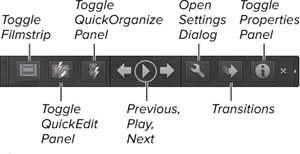
 The full-screen control bar.
The full-screen control bar. - Use the QuickOrganize panel to apply keyword tags and create new tags
 . (See “Using the Keyword Tag Cloud,” earlier in this chapter.)
. (See “Using the Keyword Tag Cloud,” earlier in this chapter.)
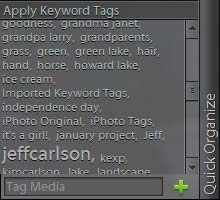
 Tag your photo or add it to an album without leaving the full-screen view.
Tag your photo or add it to an album without leaving the full-screen view.You can also use the QuickEdit panel to make basic adjustments if you’re in a hurry.
- Press Esc to exit full-screen mode when you’re finished reviewing.
Tip
If you apply a QuickEdit to a RAW image, you’re asked to save the edited version in a different file format, such as JPEG.
Tip
Click the tiny pushpin icon on the panels to toggle between remaining visible and automatically retracting to the edge of the screen.
Tip
To sort through your photos quickly, forget the panels and just type the keys 1-5 to apply ratings.
Finding Photos
In addition to locating photos using keyword tags and albums, the Organizer offers a host of other options for finding and viewing photos in your catalog. I’ll touch on just a couple of the more popular methods here for locating photos by their embedded date information. For example, the text search capability takes advantage of the keyword tags you applied earlier.
To find photos using a text search:
• Type a term into the Search field in the Options bar. The Photo Browser searches the photos’ metadata and displays matches as you type ![]() .
.
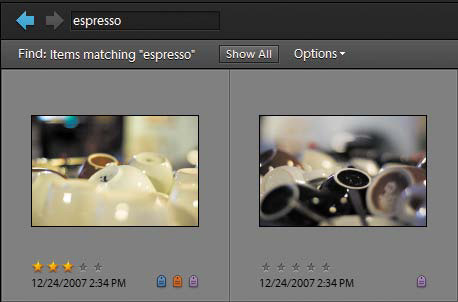
![]() Type a word in the Search field to view photos that include that term.
Type a word in the Search field to view photos that include that term.
• The Organizer is smart enough to understand the operators AND, OR, and NOT, which allow you to quickly narrow your search ![]() .
.
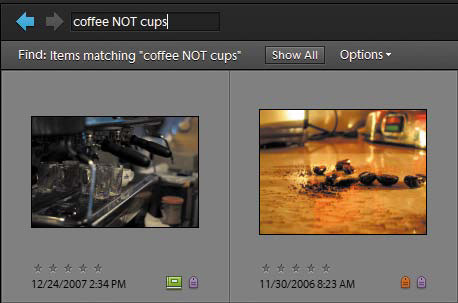
![]() You can omit terms by specifying NOT in the Search field.
You can omit terms by specifying NOT in the Search field.
• For more specific searching, enter any of the following search tags into the field. For example, typing make:canon (note the lack of a space after the colon) finds all photos in my library shot using a Canon camera. You can also group tags to narrow the results ![]() .
.
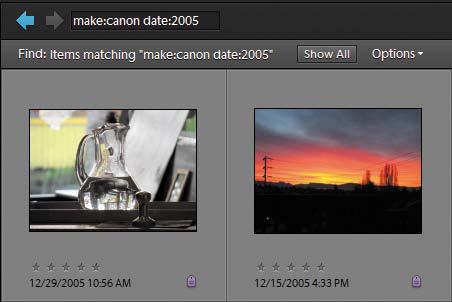
![]() Here I’ve used two terms to define a more specific search (photos shot with a Canon camera sometime in 2005).
Here I’ve used two terms to define a more specific search (photos shot with a Canon camera sometime in 2005).
• tag:
• filename:
• caption:
• make:
• model:
• author:
• notes:
• date: ##/## (month/day, depending on date preferences in Organizer)
• date: #### (year)
• date: (today, yesterday, lastweek, thisyear, or lastyear)
To find photos using the timeline:
- If the timeline isn’t visible, choose Window > Timeline (Ctrl+L).
- In the timeline, click on a bar corresponding to a specific month and year
 . The Photo Browser automatically scrolls to display the photos for the month you selected.
. The Photo Browser automatically scrolls to display the photos for the month you selected.

 Bars (month markers) in the timeline represent sets of images shot or acquired in specific months. Click a timeline marker to view its photos.
Bars (month markers) in the timeline represent sets of images shot or acquired in specific months. Click a timeline marker to view its photos.
To display photos within a date range:
- From the Find menu, choose Set Date Range, or press Ctrl+Alt+F.
- In the Set Date Range dialog, use the text fields and drop-down menus to enter your dates.
- The timeline highlights just the range of dates you selected
 .
.

 After you set a date range, only those photos that fall within the specified range are visible.
After you set a date range, only those photos that fall within the specified range are visible.
To quickly search by attributes:
Drag keyword tags, albums, or other criteria to the Find bar at the top of the Photo Browser ![]() .
.
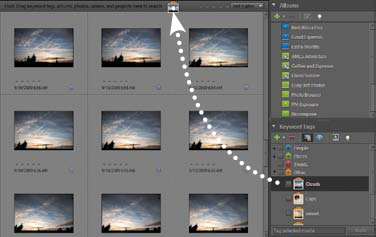
![]() Dragging the “Clouds” keyword tag to the Find bar above the Photo Browser narrows the number of displayed photos.
Dragging the “Clouds” keyword tag to the Find bar above the Photo Browser narrows the number of displayed photos.
Tip
When you drag photos to the Find bar, Elements displays images with similar qualities such as color.
To find photos in the date view:
- From the Display drop-down menu, choose Date View (Ctrl+Alt+D).
- At the bottom of the Date View window, click to select a view option
 .
.

 The date view offers three calendar layouts for viewing photos.
The date view offers three calendar layouts for viewing photos. - Use the navigation buttons in calendar view to move from one year, month, or day to another.
In Year view, dates shaded in blue indicate the days those photos were taken. A preview window to the right contains a thumbnail of the first photo in the set, plus navigation buttons to view the remaining photos in the set
 . In Month view, thumbnails appear on the dates the photos were taken.
. In Month view, thumbnails appear on the dates the photos were taken.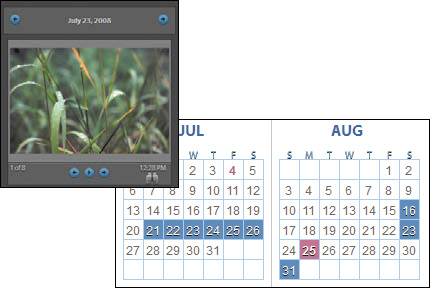
 Click a shaded date in Year view to see the photos associated with that day.
Click a shaded date in Year view to see the photos associated with that day. - To view the complete set of photos for any given day, do one of the following:
• Double-click either a shaded day in Year view or a day thumbnail in Month view.
• Click to select a day in either Year or Month view, and then click the Day button at the bottom of the Date View window.
In the Day View window you can see large, single-image views of your photos
 . You can also add notes for a complete day’s set of photos and enter a caption for individual photos.
. You can also add notes for a complete day’s set of photos and enter a caption for individual photos.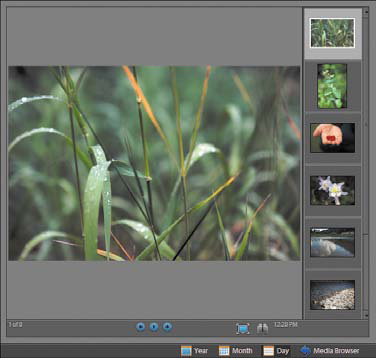
 The Day View window.
The Day View window.
Tip
From the Find menu, you can search for photos to view by a number of different criteria. Some that you’ll probably use most often are by caption or note; by filename; by history (imported on date, and printed on date, among others); and by media type (photos, video, audio, and creations). Just choose an option and then fill in its dialog (when applicable) to refine your search.
Using Stacks to Organize Similar Photos
You’ve spent a day on the valley floor of Yosemite shooting picture after picture, and when you return home in the evening and download all of those photos to your Photo Browser, you realize you have about a dozen shots of the same waterfall: some lit a little differently than others; some with different zoom settings; but all similar.
Stacks serve as a convenient way to group those related photos together. They not only save valuable space in the Photo Browser, they also make assigning tags much faster, because tagging a stack automatically tags every photo in the stack. When you’re ready to take a careful look at all of those waterfalls and weed out the greats from the not-so-greats, you simply expand the stack to view all of the stacked photos at once.
To create a stack:
- In the Photo Browser, Ctrl-click to select the photos you want to include in a stack
 .
.
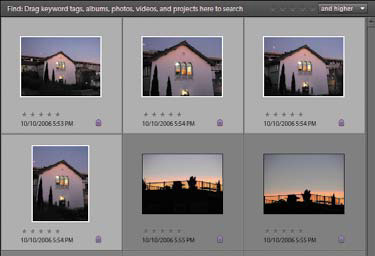
 Select similar photos to organize them into a stack.
Select similar photos to organize them into a stack. - Choose Edit > Stack > Stack Selected Photos, or press Ctrl+Alt+S.
The photos are stacked together, indicated by a Stack icon in the upper-right corner of the top photo in the stack
 .
.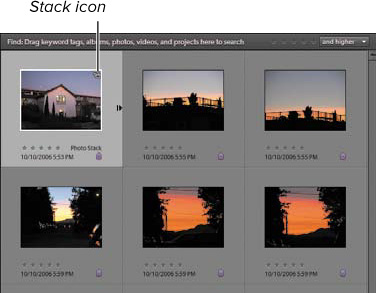
 When stacked, the photos occupy just one thumbnail, and are indicated by the Stack icon.
When stacked, the photos occupy just one thumbnail, and are indicated by the Stack icon.
To view all photos in a stack:
In the Photo Browser, click the arrow icon at the right of the stack. Or, choose Edit > Stack > Expand Photos in Stack; or press Ctrl+Alt+R. The photos in the stack appear ![]() .
.

![]() An expanded stack reveals the photos that have been grouped together.
An expanded stack reveals the photos that have been grouped together.
To flatten a stack:
- If you’re certain you don’t want any photo in a stack except for the top one, you can “flatten” the stack and delete the others. Choose Edit > Stack > Flatten Stack.
- In the warning dialog that appears, click OK to delete all of the photos except for the top photo in the stack
 .
.

 A warning box reminds you that you are about to delete all but the top photo in your stack.
A warning box reminds you that you are about to delete all but the top photo in your stack.You can also choose to delete the associated image files from your hard disk.
To unstack photos in a stack:
Choose Edit > Stack > Unstack Photos.
The stacked photos return to their original locations in the Photo Browser window.
Tip
While you’re viewing the expanded stack, you can also remove specific photos from a stack, or designate a new photo to be the top photo (the photo that appears at the top of the stack in the Photo Browser). Just right-click on any stacked photo and then, from the thumbnail contextual menu, select an option from the Stack submenu.
Using the Map
Sometimes where you took a photo is as important as what’s in the image. The Map feature lets you associate locations with your photos, using support from Yahoo! Maps ![]() .
.
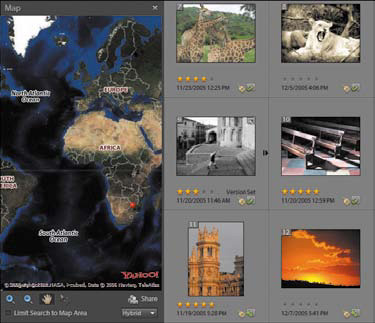
![]() The Map view lets you plot photos anywhere on the globe.
The Map view lets you plot photos anywhere on the globe.
To place a photo on the map:
- Right-click one or more photos and choose Place on Map from the contextual menu.
- In the Photo Location on Map dialog, type an address
 .
.
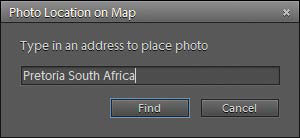
 Enter an address, city, state, or country (or any of the above) to find the location.
Enter an address, city, state, or country (or any of the above) to find the location. - Elements checks online for a match and displays the results; select the one closest to the location you’re looking for and click OK.
A red pushpin icon appears in the Map pane at the location you specified. Clicking the icon displays the photo
 .
.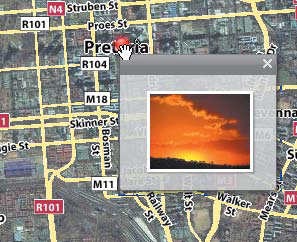
 Clicking a marker on the map displays a window containing thumbnails of the photos associated with that location.
Clicking a marker on the map displays a window containing thumbnails of the photos associated with that location. - Use the Zoom, Hand, and Move tools to navigate the map.
Tip
You can also choose Show Map from the Display drop-down menu to view the Map pane and then simply drag photos to a location on the map to place them. However, the steps above make it easier to find specific locations, versus dropping a bunch of pictures onto “North America” and calling it good.
Tip
When creating tags, click the Place on Map button to specify a location in the Map pane. Any photo assigned that tag automatically appears on the map.
Tip
The pop-up menu at the lower-right corner of the Map pane lets you display a traditional map, a satellite image, or a hybrid version (satellite with street names superimposed over it).
To move a location on the map:
Right-click a pushpin icon and choose Place on Map; follow the directions on the previous page.
Or
- Click the Move tool in the Map pane.
- Drag a pushpin icon to another location.
All photos associated with that location are marked with the new location.
To remove a photo from the map:
In the Map pane, right-click a pushpin icon and choose Remove from Map ![]() .
.

![]() Right-click a pushpin icon on the map to remove the photos from the map.
Right-click a pushpin icon on the map to remove the photos from the map.
Using Catalogs to Store Your Photos
Catalogs are the behind-the-scenes backbone of the Organizer workspace, where all the information for tags and categories and albums are stored. When you install Elements, a default catalog (called My Catalog) is set up for you. That might be enough to work with, but you can also create additional catalogs—for example, if more than one person is using the same computer. You may want discrete catalogs for each person’s photos: Bob’s Catalog, Sara’s Catalog, and so on.
To create a new catalog:
- From the File menu choose Catalog, or press Ctrl+Shift+C.
- In the Catalog Manager dialog, click a radio button to specify whether the catalog is available to all user accounts on the computer, just the current user, or saved to a custom location
 .
.
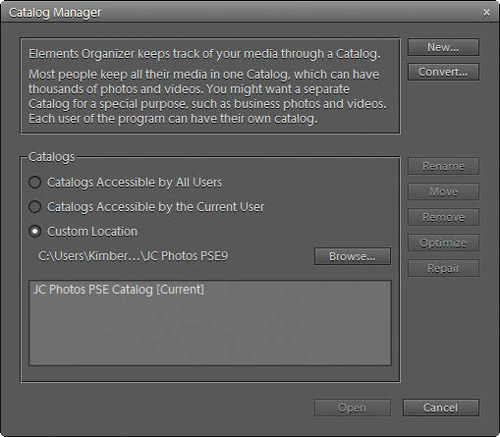
 Choose which users and locations the catalog belongs to.
Choose which users and locations the catalog belongs to. - Click the New button.
If online backups are enabled for your existing catalog, a warning dialog appears stating you’ll need to set the new catalog to be backed up in the Backup/Sync preferences (see the next section). Click OK to continue.
- In the File name text field, enter a name for your new catalog
 .
.
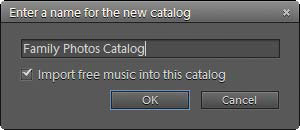
 Make sure to name your new catalog differently than any existing catalogs.
Make sure to name your new catalog differently than any existing catalogs.At the bottom of the naming dialog is the Import free music into this catalog checkbox. Leave this option selected so the music files you received with Elements (to use as background tracks for PDF slide shows and other creations) will be available in the new catalog.
- Click OK to create your new catalog.
To access saved catalogs:
- From the File menu choose Catalog, or press Ctrl+Shift+C.
- Select the name of the saved catalog you want to open
 .
.
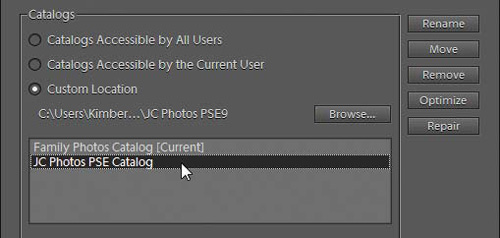
 Juggle multiple catalogs using the Catalog Manager dialog.
Juggle multiple catalogs using the Catalog Manager dialog. - Click the Open button.
To make a backup of a catalog:
- Since you obviously don’t want to lose your photos, choose File > Backup Catalog to Hard Drive.
- In the Backup dialog, choose Full Backup to make a complete copy of the catalog. On subsequent backups, you can choose Incremental Backup to copy only new and changed image files.
- Click Next.
- Select a destination drive from the list, and specify a location by clicking the Browse button for Backup Path
 .
.
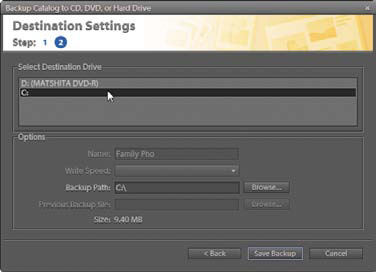
 Specify where your backup files are to be copied.
Specify where your backup files are to be copied. - Click Done when you’re ready. Elements copies the image files and catalog information to the drive.
To restore a catalog from backup:
- In the event that your catalog becomes unreadable, choose File > Restore Catalog from Hard Drive.
- In the Restore dialog, choose the media on which the backup is stored
 ; click the Browse button to locate the
; click the Browse button to locate the .tlyfile that accompanies the backup.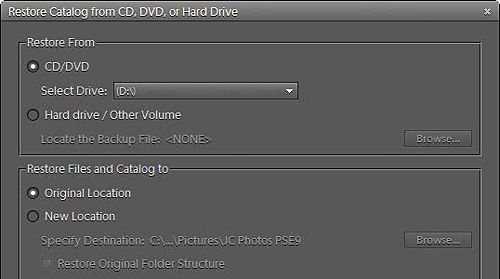
 If you need to reconstruct a catalog from your backup, use the Restore Catalog command.
If you need to reconstruct a catalog from your backup, use the Restore Catalog command. - Choose where to copy the restored files: the catalog’s original location or another location.
- Click Restore. The images and catalog information are copied to the destination.
Tip
Restoring a catalog isn’t just for when disaster strikes. If you need to move a catalog to another computer, create a full backup first, and then use the Restore feature in Photoshop Elements on the other machine.
Backing Up Photos Online
The capability to back up your catalog to an external hard disk or removable media has one limitation: You need to actually do it. And speaking from experience, that’s something easily forgotten or put off for another day. But hard drives don’t fail on a schedule, and thieves don’t wait to pilfer your laptop until it’s most convenient for you.
I covered the basics of the integration between Elements and Photoshop.com in Chapter 1. With an account set up, you can direct Elements to back up your photos over the Internet in the background. Even if your computer perishes in a natural disaster, your photos are safe on Adobe’s servers.
Elements also synchronizes your backup. If you make a change to a photo in your library or online, the change is reflected in both locations.
To set up Photoshop.com backups:
- Sign in to your Photoshop.com account if you haven’t already.
- In the Organizer, choose Edit > Preferences > Backup/Synchronization.
You can also click the synchronization status icon at the bottom of the Organizer screen and choose Open Backup/Synchronization preferences from the pop-up menu that appears
 .
.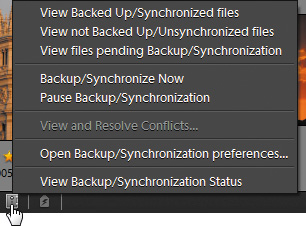
 Access the Photoshop.com backup settings from the synchronization status icon.
Access the Photoshop.com backup settings from the synchronization status icon. - Enable the Backup/Sync is On checkbox if it’s not already active
 , and click OK.
, and click OK.
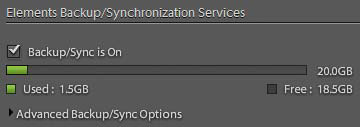
 The master switch for enabling backups is in the Backup/Synchronization preferences.
The master switch for enabling backups is in the Backup/Synchronization preferences.
Backing up albums
Elements primarily organizes online backups by album. This approach cuts the amount of data transferred (since image files tend to be quite large) and lets you decide which photos are backed up.
To enable an album for online backup:
- Create a new album, or select an existing album and edit it (see “Using Albums to Arrange and Group Photos,” earlier in this chapter). The Album Details dialog fills the Organize panel.
- Enable the Backup/Synchronize checkbox
 .
.
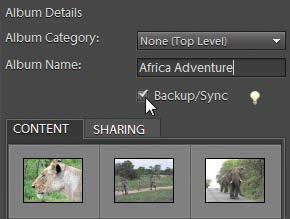
 Enable the Backup/Synchronize checkbox to copy the contents of an album to Photoshop.com.
Enable the Backup/Synchronize checkbox to copy the contents of an album to Photoshop.com. - Click Done. The album icon displays a pair of icons indicating that it gets synchronized, and each photo in the album gains a pending synchronization icon
 .
.
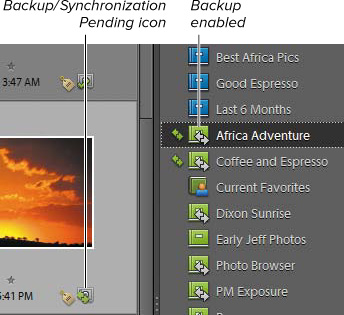
 You can tell at a glance which photos and albums are getting backed up.
You can tell at a glance which photos and albums are getting backed up.Elements copies the images to the Photoshop.com servers in the background while you perform other tasks.
To view the backup status:
Click the synchronization status icon and choose one of the first three items in the menu to display: files that have been backed up; files that are not set for backup; or files that are due to be backed up. The photos appear in the Photo Browser.
Tip
New albums are automatically set to be backed up. To turn off this behavior, disable the New Albums Will Backup/Sync Automatically checkbox in the Backup/Synchronization preferences under Advanced Backup/Sync Options.
To control when backups occur:
• Click the synchronization status icon and choose Pause Backup/Synchronization from the status icon pop-up menu to temporarily halt copying. Use this command when you want to maximize your Internet bandwidth for other tasks.
• Click the Elements Organizer menu bar item and choose one of the following options ![]() :
:

![]() The Elements Organizer menu bar menu controls when images are copied.
The Elements Organizer menu bar menu controls when images are copied.
• Backup/Sync only when idle: Elements copies files only when you’re not using the computer.
• Backup/Sync Now: Synchronize immediately.
• Pause Backup/Synchronization: Temporarily halts copying.
• Stop Backup/Synchronization: Disables the Backup/Sync is On setting in the Elements preferences and ends the agent. You must go back to the preferences to restart the service.
To stop backing up an album:
- Select an existing album and edit it.
- In the Album Details dialog, disable the Backup/Synchronize checkbox.
- Click Done.
When you turn off backup/synchronization, Elements no longer communicates with Photoshop.com about the photos in that album. However, the images still remain online; if you want to delete them from Photoshop.com, you need to do so there.
Tip
To see what’s being transferred, choose View Backup/Synchronization Status from the synchronization status icon ![]() .
.
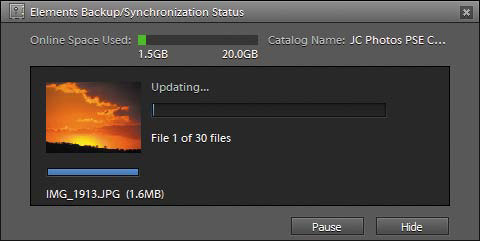
![]() In the Backup/Synchronization preferences, click the Sync checkbox for the albums you wish to sync.
In the Backup/Synchronization preferences, click the Sync checkbox for the albums you wish to sync.
Synchronizing Photos with Photoshop.com
Communication between Elements and Photoshop.com goes both ways. When you edit a photo in Elements, the changes are automatically uploaded to your library at Photoshop.com and vice-versa. You can specify which albums are synchronized in the Backup/Synchronization preferences ![]() .
.
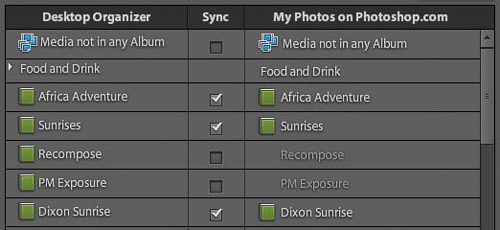
![]() In the Backup/Synchronization preferences, click the Sync checkbox for the albums you wish to sync.
In the Backup/Synchronization preferences, click the Sync checkbox for the albums you wish to sync.
Here’s how synchronization works:
• Elements copies all files in an album to Photoshop.com. However, the online service only works with JPEG images, so if you want to edit a raw file, for example, Photoshop.com first converts the image.
• When you edit a file at Photoshop.com, the edited version is added to your Elements library as a new version; the original is still available.
• If you edit an image in Elements, only the most recent version of the file is uploaded to Photoshop.com ![]() . The original version exists only in your Elements library.
. The original version exists only in your Elements library.

![]() At Photoshop.com, the original version of the image at right was replaced by this version that was edited in Elements.
At Photoshop.com, the original version of the image at right was replaced by this version that was edited in Elements.
• If your Elements album contains a version set, only the “top” version (the latest) is uploaded to Photoshop.com, not all versions in the set.
• Removing a photo from an album in either Elements or Photoshop.com does not delete the file; it’s still available in the libraries at both locations.
• If you delete an album in Elements that you’ve shared (made public), the photos still reside at Photoshop.com but are no longer publicly available.
• If you delete a synchronized photo from Photoshop.com, Elements alerts you that a synchronization problem exists (see below). You can remove this confirmation step by disabling the preference labeled When I Delete a File Online, Ask Before Deleting It from My Computer.
• If you edit several different aspects of a photo—for example, adding a caption at Photoshop.com and applying keywords in Elements—those changes are merged so that each version is the same.
Resolving synchronization issues
Sometimes synchronization isn’t straightforward. What happens when you add a caption to a photo in Elements and then accidentally add a different caption for the same photo at Photoshop.com? The synchronization status icon turns yellow to indicate a conflict.
To resolve synchronization issues:
- Click the synchronization status icon and choose View and Resolve Conflicts from the pop-up menu
 .
.
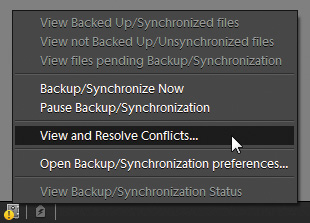
 The yellow synchronization status icon indicates you need to resolve a conflict.
The yellow synchronization status icon indicates you need to resolve a conflict. - In the Backup/Synchronization Resolution dialog, review the conflicts and choose the version you wish to keep
 .
.
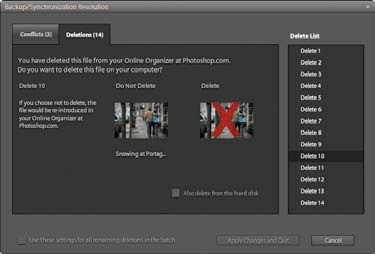
 Elements details the sync conflicts and lets you choose which version to keep.
Elements details the sync conflicts and lets you choose which version to keep.If you’ve deleted a file from the library (not just removed it from an album), as I mentioned above, the Deletions tab lets you confirm or reject the deletion.
- Click the Apply Changes and Quit button to resolve the conflicts.
Tip
Photoshop.com doesn’t automatically update its library when you’re viewing an album online. If you’re expecting synchronized files to appear, click the Refresh button to update the library ![]() .
.

![]() Click the Refresh button to update the library.
Click the Refresh button to update the library.


